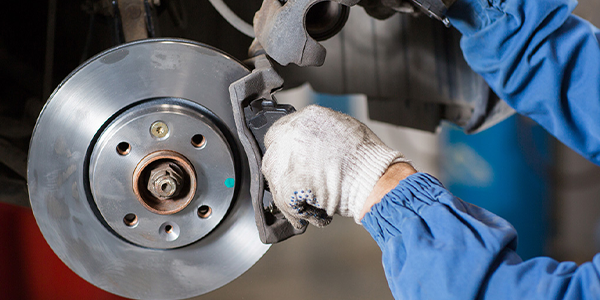Now that the warped rotor myth is busted, and we’re not just replacing the rotor and moving on, what are we doing instead?
Measuring runout
First, check for rotor surface runout with the wheel mounted. Components should be marked as you perform an inspection of the assembly. By measuring the rotor on the hub, you can also check for play in the wheel bearings, corrosion on the mounting surface and other possible errors.
Check the bearing endplay, and mark the relation of the rotor to the bearing flange. Mark the high and low runout spots on the rotor friction surface, with the low spot marked as zero and the high spot as 0.XX”. After checking friction surface runout, check the bearing flange runout. Mark the high and low runout spots on the bearing flange with the same method as the rotor friction surface.
Measured values should be compared to published service limits, but on many vehicles, the mounted runout is easily 0.0019” (0.05 mm or 50 microns) or less.
The clamp load of the lug nuts can have a significant impact on the final lateral runout of the wheel end and make for a difficult measurement. The next best measurement is with the wheel off, but clamped down with the lug nuts. Conical washers matched to your lug nuts provide the most consistent reading.
Here is what you’ll need to diagnose and repair the condition correctly:
Dial Gauge. A dial gauge is used to measure runout in the rotor and hub assembly. Always use a dial indicator to verify the amount of runout present in a rotor and hub assembly, both before and after the rotors have been machined. This must be performed even if you are using an on-the-car lathe. Even if you are putting new rotors on a vehicle, runout should be checked. Also, if you are using a bench lathe, the dial indicator can be used to check to see if you have mounted the rotor or drum properly to the lathe.
Correction Plates. Flange runout can be corrected with tapered correction plates that are available to correct a runout of 0.003” to 0.009”. A runout of more than 0.005” at the bearing flange cannot be corrected by the use of a correction plate.
Lathes. A bench lathe machines a rotor in the same plane as the arbor, and it will remove lateral runout in the rotor, but not runout that is in the flange.
An on-the-car lathe can help to reduce runout by truing a rotor in its operating plane on the vehicle. This means that the rotor is machined to match the hub.
Pads. The pads used for each application can make a big difference. OEMs engineer the brake package on a vehicle to work with specific friction material profiles. Some vehicles are engineered for ceramic or organic formulations that put a transfer layer of material on the rotor to interact with the pads. Some vehicles use abrasive materials that wear the rotor along with the pads. Try sticking with the similar friction material profiles.
Regardless of the formulation used, if the brake system is used to the intended limits and the brake pads go beyond their operational temperature limit, they will deposit brake pad material unevenly on the brake rotor. Pad material buildup leads to DTV. The remedy to this is to clean up the rotors with a light pass on the lathe so the new pads are not contaminated by the deposits.














